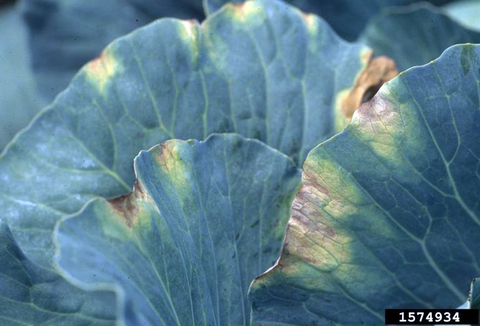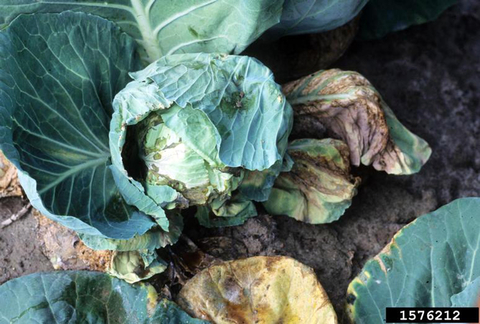Quick facts
- Black rot is one of the most common diseases of broccoli, kale, and other Brassica crops.
- It affects leaves, and often results in head rot. It can be severely yield limiting.
- A few cabbage varieties have some degree of tolerance, but for the most part, resistant cultivars are not currently available.
- Black rot is a bacterial disease that spreads through water. Managing water is key to managing this disease.
How to tell black rot from other brassica issues
- Initially, symptoms begin as yellowing at leaf edges, which turns into characteristic V-shaped lesions.
- As symptoms progress, plants can develop blackened vascular tissue and head rot.
- Plants can be affected at any stage of maturity.
Biology
- Black rot is caused by the bacteria Xanthamonas campestris pv campestris.
- This bacteria can infect any plant in the Brassica family, but tends to be most damaging in broccoli, cabbage, cauliflower, and kale.
- Black rot often enters farms and gardens via infected seed.
- Once present, black rot can persist in residues.
- Bacteria enter plants through pores at the leaf margins called hydrathodes where dew accumulates in the morning. The bacteria can also enter the plant through infected seed, or wounds from hail damage, mechanical injury or insect feeding.
- Some studies show that flea beetles and other insects may transmit the bacteria from plant to plant.
- Black rot spreads easily by water.
- Black rot spreads most readily in warm conditions (above 77 degrees F) with high humidity.
Managing black rot in the home garden
Black rot-resistant cabbage varieties are available. The variety Capture has shown the highest degree of resistance in trials up to this point.
While some varieties of broccoli are listed as resistant, the degree of resistance displayed in field conditions is highly variable.
- Buy seed from companies that screen for black rot; this is often listed in seed catalogs.
- Only save seed from healthy plants.
- Water at the base of each plant, using drip irrigation, a soaker hose, or careful hand watering. Water in the morning after the dew has evaporated from plant leaves.
- Let three years pass before you plant Brassica plants in the same location
- Increase airflow by spacing plants adequately apart. Ideal broccoli spacing is 10–18 inches apart in rows 18–36 inches apart.
- Let 3 years pass before you plant Brassica crops in the same location.
- After harvest, remove the crop residue from your garden. It can be composted or tilled back into the soil.
- Pay close attention to weeds in the Brassica family such as shepherd’s purse, black mustard and field mustard. Remove them from your garden so they do not act as hosts for black rot.
- Clean and sanitize trays used for starting seeds each year.
If symptoms are limited to a few plants, remove infected plants as soon as symptoms appear. Be sure to remove the entire plant, not just the leaves. If all plants are affected, remove infected leaves.
If you touch infected leaves, wash your hands well before working in healthy Brassica plants. If you use pruning tools, wash and sanitize them after touching infected plants.
Black rot is a bacterial disease, so fungicides are ineffective.
Focus on good cultural and physical controls.
Managing black rot on farms
- Black rot can appear in early spring in Minnesota, and often becomes widespread in late summer.
- If seeds are infected, you might see initial symptoms in transplant trays. These symptoms can look like yellow spots on leaves.
- In the field, scout often for initial symptoms in order to begin managing the disease as soon as it appears.
Black rot-resistant cabbage varieties are available. The variety Capture has shown the highest degree of resistance in trials up to this point.
While some varieties of broccoli are listed as resistant, the degree of resistance displayed in field conditions is highly variable.
- Buy seed from companies that screen for black rot; this is often listed in seed catalogs. Check with your local seed rep if this information is not readily available.
- Screen transplants for symptoms before bringing them into the field.
- Let three years pass before you plant Brassicas in the same location.
- Avoid planting Brassica crops in fields with poor drainage, or fields that may receive runoff from fields where Brassicas were recently grown.
- Use drip irrigation on Brassica plants. Even if your farm primarily relies on overhead irrigation, black rot is typically severe enough and consistent enough to justify drip irrigation. Water in the morning after the dew has evaporated from plant leaves.
- Avoid working in plants when they are wet from rain, irrigation, or dew.
- Increase airflow by spacing plants adequately apart. Ideal broccoli spacing is 10–18 inches apart in rows 18–36 inches apart.
- Avoid using tillage radish, winter camelina, and other Brassicas as cover crops.
- Destroy crop debris immediately after harvest by flail mowing or tilling.
- Pay close attention to weeds in the Brassica family such as shepherd’s purse, black mustard and field mustard. Remove them from your garden so they do not act as hosts for black rot.
- Clean and sanitize trays used for starting seeds each year, as well as any equipment used in fields with disease pressure.
Since black rot is a bacterial disease, fungicides are ineffective. Copper products are most commonly used, but overreliance on copper can lead to resistance.
There are also biopesticides labeled for black rot, which can be used in combination with copper. In all cases, applications should be made early and preventatively for maximum effect.
See the Midwest Vegetable Production Guide for current recommendations. Cornell University maintains a list of biopesticides labeled for bacterial diseases.
CAUTION: Mention of a pesticide or use of a pesticide label is for educational purposes only. Always follow the pesticide label directions attached to the pesticide container you are using. Be sure that the plant you wish to treat is listed on the label of the pesticide you intend to use. And observe the number of days between pesticide application and when you can harvest your crop. Remember, the label is the law.
Reviewed in 2022




